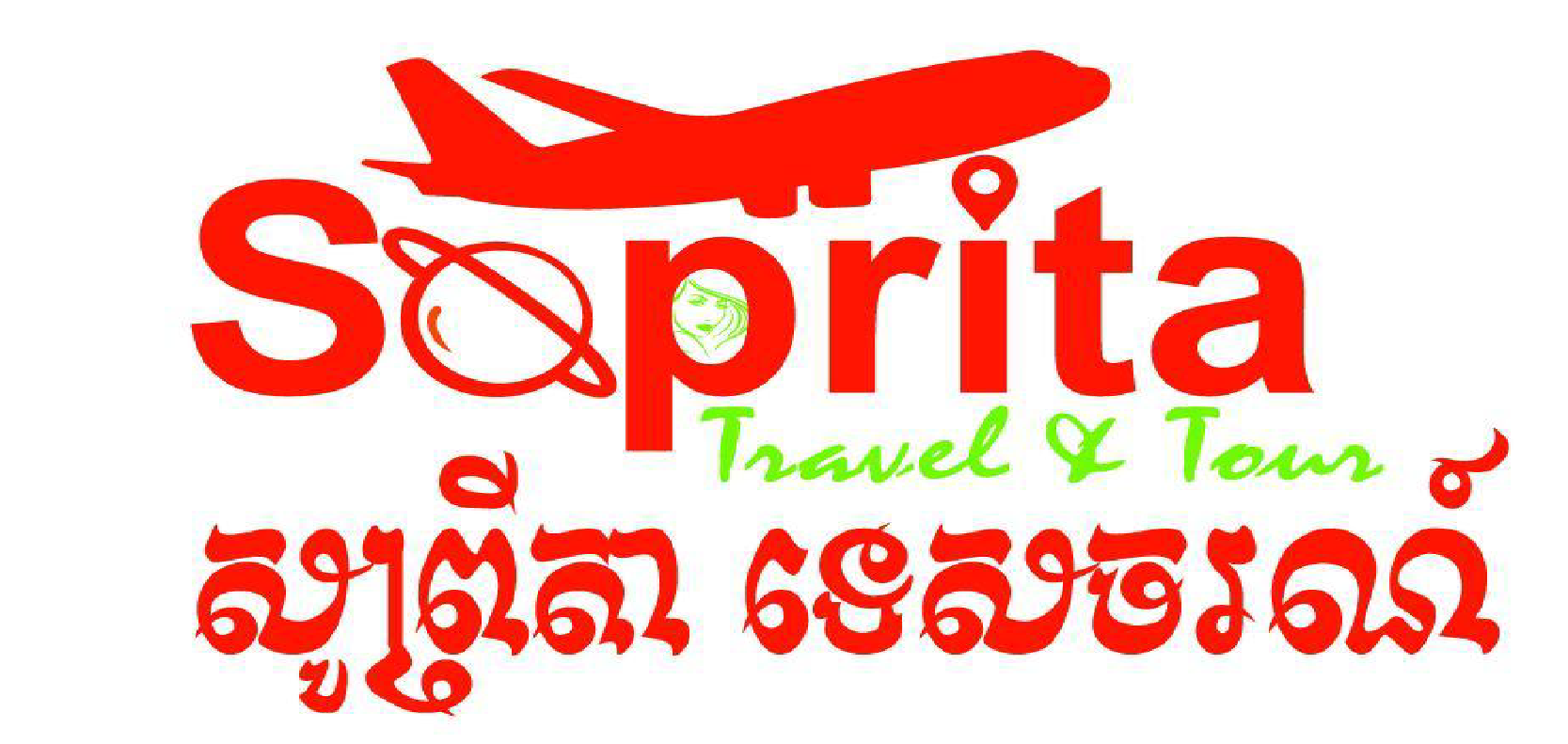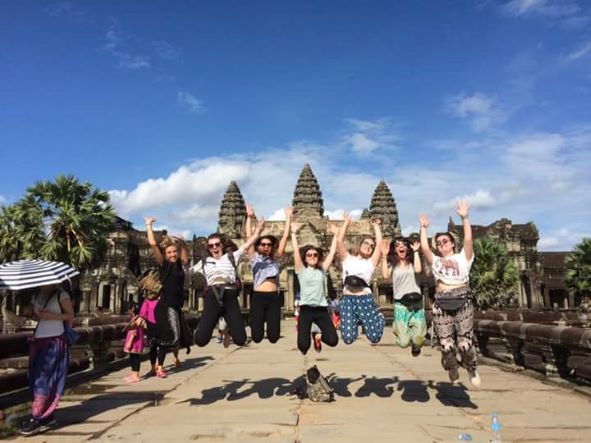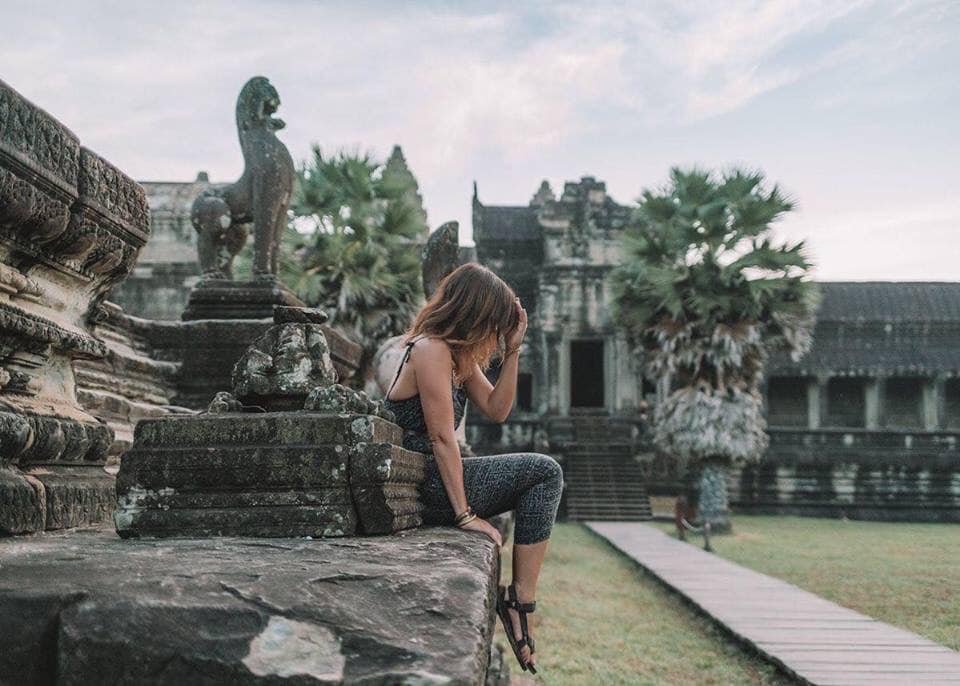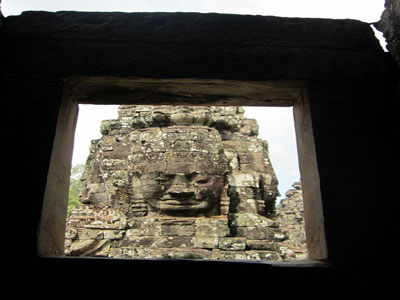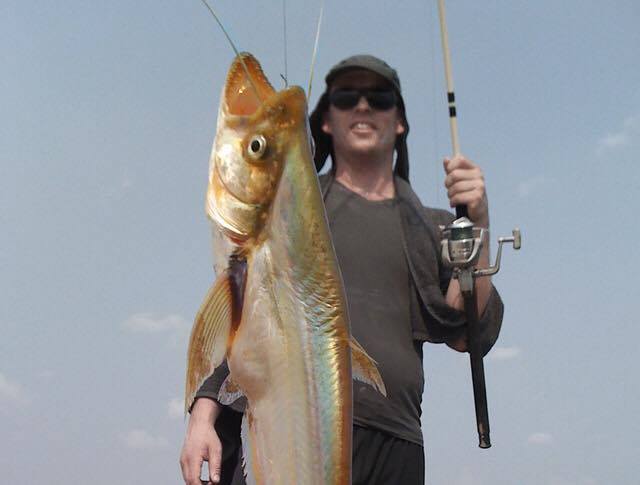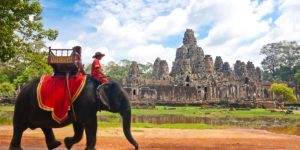 Siem Reap (Khmer: ក្រុងសៀមរាប, pronounced [siəm riəp]; Thai: เสียมราฐ) is the capital city of Siem Reap Province in northwestern Cambodia. It is a popular resort town and a gateway to the Angkor region.
Siem Reap (Khmer: ក្រុងសៀមរាប, pronounced [siəm riəp]; Thai: เสียมราฐ) is the capital city of Siem Reap Province in northwestern Cambodia. It is a popular resort town and a gateway to the Angkor region.
Siem Reap has colonial and Chinese-style architecture in the Old French Quarter, and around the Old Market. In the city, there are museums, traditional Apsara dance performances, a Cambodian cultural village, souvenir and handicraft shops, silk farms, rice-paddies in the countryside, fishing villages and a bird sanctuary near the Tonle Sap Lake, and a vibrant, cosmopolitan drinking and dining scene.
Siem Reap today—being a popular tourist destination—has a large number of hotels, resorts, restaurants and businesses closely related to tourism. This is much owed to its proximity to the Angkor temples, the most popular tourist attraction in Cambodia.
Angkor Wat – Heritage of Humanity and World Wonder
Angkor Wat which literally means ‘City Temple’ is a Hindu temple complex built to replicate the heavens on earth. Constructed for King Suryavarman II in the early twelfth century, it is the best-preserved temple and is the only one to have remained a significant religious centre since its foundation; first Hindu, dedicated to Vishnu, then Buddhist. The temple is the epitome of the high classical style of Khmer architecture. This magnificent temple combines two basic plans of Khmer temple architecture; the temple mountain and the later galleried temple, based on early South Indian Hindu architecture. Constructed within a moat and an outer wall 3.6 kilometres (2.2 miles) long with three rectangular galleries, each raised above the next, it is designed to represent Mount Meru, home of the devas in Hindu mythology.
At the centre of the temple stands a quincunx of towers. Unlike most Angkorian temples, Angkor Wat is oriented to the west and this has scholars divided as to its significance. The temple is admired for the grandeur and harmony of the architecture. The extensive bas-reliefs and the numerous guardian spirits adorning its walls serve as evidence of the strong Khmer religious beliefs.
Bayon Temple
Bayon is a richly decorated Khmer temple built in the late twelfth century or early thirteenth century. Built at the centre of King Jayavarman’s capital, Angkor Thom was the last state temple to be built at Angkor, and the only Angkorian state temple to be built primarily as a Mahayana Buddhist shrine dedicated to the Buddha. Following Jayavarman’s death, it was modified and augmented by later Hindu and Theravada Buddhist kings in accordance to their religious preferences.
Bayon’s most distinctive feature is the multitude of serene and massive stone faces on the many towers that jut from the upper terrace and cluster around its center peak. The similarity of the 216 gigantic faces to other statues of Jayavarman VII has led many scholars to the hypothesise that the faces are representations of the king himself. Others believe that the faces belong to Avalokitesvara, the bodhisattva of compassion.
The temple is also popular for two impressive sets of bas-reliefs, which present an unusual combination of mythological, historical, and mundane scenes. This is one of the many ‘must visit’ temples.
Banteay Srei Temple
Consecrated in 967 A.D, Banteay Srei was speculated to have been known earlier as Banteay Serai, which literally means the Citadel of Victory. This was the only major temple at Angkor not built by a monarch; its construction is credited to a courtier named Yajnavaraha, who was a scholar and philanthropist and a counselor to king Rajendravarman. He was known to have helped those who suffered from illness, injustice or poverty.
Banteay Srei is built primarily in red sandstone, a medium that lends itself to the elaborate decorative wall carvings which are still observable in fine details today. Measured by the standards of Angkorian construction, the buildings themselves are miniature in scale. These factors have led to its being widely praised as a ‘precious gem’, or the ‘jewel of Khmer art’ and perhaps the temple’s modern name, Banteay Srei or Citadel of Women, is probably related to the intricacy of the bas relief carvings of devatas found on the walls and the tiny dimensions of the buildings themselves.
Phnom Bakheng
Phnom Bakheng was constructed more than two centuries before the Angkor Wat. It is a Hindu temple originally built in the form of a temple mountain dedicated to Shiva. Historians believe that Phnom Bakheng was in its heyday, the principal temple of the Angkor region. It was the architectural centerpiece of a new capital that Yasovarman built when he moved the court from the capital Hariharalaya in the Roluos area located to the southeast.
Located atop a hill, this is the most popular tourist spot for sunset views of the much bigger Angkor Wat temple which lies amid the jungle about 1.5 km away.
Preah Khan Temple
Preah Khan was built on the site of Jayavarman VII’s victory over the invading Chams in 1191.
In its heyday, this was the centre of a substantial organisation with almost 100,000 officials and servants. This temple is flat in design, with a basic plan of successive rectangular galleries around a Buddhist sanctuary complicated by Hindu satellite temples and numerous later additions. With numerous trees and other vegetation growing among the ruins, Preah Khan has been left largely unrestored.
Kulen Mountain National Park
The Kulen Mountain or Phnom Kulen is declared as a National Park. It is an isolated mountain massif located in Svay Leu District and some 48km from Siem Reap. Its highest point is 487 meters.
This is widely regarded as the birthplace of the ancient Khmer Empire. During the constructional period of the ancient temples in the nineth century, sand stones were brought from this sacred mountain to Angkor. It was here at Phnom Kulen that King Jayavarman II proclaimed independence from Java in 802 A.D.
The site is known for its carvings representing fertility and its waters hold special significance to the people of Cambodia. Just a few inches under the surface of the water, over 1000 carvings of Yoni and Linga are etched into the sandstone riverbed. The waters are regarded as holy, given the sacred carvings which also include a stone representation of the Hindu god Vishnu lying on his serpent Ananta, with his wife Lakshmi at his feet. A lotus flower protrudes from Vishnu’s navel bearing the god Brahma. The river then ends with a beautiful waterfall. Phnom Kulen is regarded highly by Cambodian people as a sacred location and has developed into a great tour destination.
Phnom Krom – Tonle Sap Lake
Tonle Sap, the largest freshwater lake in Southeast Asia, is itself a natural wonder.This great lake exists as an ecological anomaly. In early June, at the start of the rainy season, the water level of the Mekong River rises to divert part of its flow off its course to the South China Sea and redirect it into the Tonle Sap. This forces the current to reverse direction, beginning a process that by the end of October will see the great lake increasing its size almost tenfold, making it the largest freshwater body in Southeast Asia.
The Tonle Sap Lake, fed by the mighty Mekong and the Tonle Sap Rivers, is a vast expanse of water that forms the most significant topographical feature in Cambodia. This ‘Great Lake’ represents a people’s identity and way of life for the thousands of Cambodians who live on the lake and are dependent on the Tonle Sap and its ebbs and flows to maintain life.
There is a whole community here; besides homes, there is a school, police post, fire station, church and a few restaurants as well. This self-sufficient community of the great lake, known commonly as the floating village of Cambodia, draws crowds daily to observe life and to share their time in this wonderful neighborhood of the great Tonle Sap Lake.
Angkor Thom Temple
Angkor Thom is a very popular tourist spot. It was established in the late twelfth century to early thirteenth century by King Jayavarman VII. This site is situated 1.7 Km north of Angkor Wat, within which are located several monuments from earlier eras as well as those established by Jayavarman and his successors.
The fortified city of Angkor Thom, some 9sq km in extent, was the last and most enduring capital city of the Khmer empire built by Angkor’s greatest King, Jayavarman VII (ruled 1181-1201).
Centered on Baphuon, Angkor Thom is enclosed by a square wall 8m high and 12km in length and encircled by moat 100m wide. The city has five monumental gates, one each in the north, west and south walls and two in the east wall. In front of each gate stand giant statues of 54 gods (to the left of the causeway) and 54 demons (to the right of the causeway), a motif taken from the story of the Churning of the Ocean of Milk illustrated in the famous bas-relief at Angkor Wat. In the center of the walled enclosure are the city’s most important monuments, including the Bayon, the Baphuon, the Royal Enclosure, Phimeanakas and the Terrace of Elephants.
Cultural Village
The Cambodian Cultural Village is designed to provide tourists with an excellent insight into the life and culture of the Cambodians; their traditions and practices, etc.
In all, eleven villages or sectors, each a showcase of different landmarks and providing a peek into the lifestyles of the people from various provinces including the ethnic minorities.
Like a theme park, tourists are treated to miniatures of historical buildings, stone carvings, wood works and many forms of arts and crafts.
There are performances; dances of the ethnic groups, traditional wedding ceremony, circus acts, acrobats, elephant shows, Khmer boxing, the famous Apsara dance and more to entertain the tourists.
Angkor National Museum
The Angkor National Museum is classified as one of Cambodia’s premier museum sites. On display are thousands of important Buddhist and Hindu sculptures from the various Angkor temples.
Many original pieces recovered for safe-keeping by the authorities from the temple ruins are also on exhibit at this museum.
Since the discovery of the Angkor temples, many of the antique artifacts have been stolen and sold to private collectors, museums and auction houses all over the world. Over the years, efforts have been made by the Royal Cambodian government to recover them and with the cooperation of various government agencies from around the world, many of the lost pieces have found their way back to Cambodia.
The Angkor National Museum houses and exhibits many of the recovered items amongst the several thousand exhibits now on display. In this very modern building, tourists will discover the Golden Era of the Khmer Kingdom and through state of the art multimedia technology, enjoy a full story of the legend.
River of One-Thousand Lingas
It is located at the foot of the mountain. Along the river of Siem Reap, there are a lot of figures of Yoni and Linga spreading out at its bottom.
Terrace of the Elephants
The Terrace of the Elephants is part of the walled city of Angkor Thom. The terrace was used by king Jayavarman VII as a platform from which to view his victorious returning army. It was attached to the palace of Phimeanakas. Most of the original structure was made of organic material and has long since disappeared and most of what remains are the foundation platforms of the complex. The terrace is named for the carvings of elephants on its eastern side.
The 350m-long Terrace of Elephants was used as a giant reviewing stand for public ceremonies and served as a base for the king’s grand audience hall. It has five outworks extending towards the Central Square-three in the centre and one at each end. The middle section of the retaining wall is decorated with life size garudas and lions; towards either end are the two parts of the famous parade of elephants complete with their Khmer mahouts.
Srah Srang ‘the royal bath’
It was perhaps a chapel to Kama, God of Love. The spot would suit the temper of the strange power, terribly strong and yet terribly tender, and of that passion which carries away kingdoms, empires and whole worlds. Love could occupy this quiet nest embedded in water, which gave the impression that love had come one day and had left there, when he went away, a part of his spirit.
Pre Roup Temple
Architecturally and artistically superior temple-mountain. Beautifully carved false doors on upper level, as well as an excellent view of the surrounding countryside. Richly detailed, Well-preserved carvings. Traditionally believed to be a funerary temple, but in fact the state temple of Rajendravarman II. Historically important in that it was the second temple built after the capital was returned to Angkor from Koh Ker after a period of political upheaval. The artistically similar East Mebon was the first to be constructed after the return to Angkor, less than a decade earlier.
East Mebon Temple
East Mebon temple is a large temple-mountain-like ruin, rising three levels and crowned by five towers. Jayavarman IV, a usurper to the throne, moved the capital from Angkor to Koh Ker in 928AD. Sixteen years later Rajendravarman II returned the capital to Angkor and shortly thereafter constructed East Mebon on an island in the middle of the now dry Eastern Baray. The temple is dedicated to shiva in honor of the king’s parents. Inscriptions indicate that it was also built to help reestablish the continuity of kingship at Angkor in light of the interruption that occurred when the seat of power had been moved to Koh Ker. There seems to be some scholarly debate as to whether East Mebon should be categorized as a temple-mountain. Inscriptions record activity at the temple as early as 947AD, but East Mebon was not consecrated until 952AD.
Boeng Melea Temple
The remains of Boeng Mealea, which are still partly buried under vegetation, consist of perfectly squared-off sandstone building blocks. The outstanding decoration dates from the fist half of the 12th century.
In various times, the pediments of some buildings are sculpted with narrative scenes from the Ramayana, and while Hindu iconographic themes are plentiful, Boeng Mealea is clearly a Buddhist sanctuary as Banteay Samre, which is more or less contemporaneous. This is confirmed by the magnificent statue of the Bodhisattva Lokeshvara discovered in the monument and today housed at the Angkor Conservancy.
Ak Yum
The historically important ruins of a small brick and sandstone temple in very poor condition. The earliest elements date from the pre-Angkorian 8th century, Inscriptions indicate that a temple dedicated to the Hindu ‘god of the depths’ was previously located on the same spot. Ak Yum is the earliest known example of the ‘temple-mountain’ architectural design formula, which was to become a primary design formula for many of the Angkorian period temples including Angkor Wat.
Kbal Spean
This holy place must have been favored during the great Angkorean epoch when its waters, after having washed gods and lingas, continued on to the wondrous royal city with its growing monumental temples.
Banteay Samre
Large, comparatively flat temple displaying distinctively Angkor Wat-style architecture and artistry. The temple underwent extensive restoration this century by archaeologists using the anastylosis method. Banteay Samre was constructed around the same time as Angkor Wat. The style of the towers and balustrades bear strong resemblance to the towers of Angkor Wat and even more so to Khmer temple of Phimai in Thailand. Many of the carvings are in excellent condition. Banteay Samre id a bit off the Grand Circuit, near the southeast corner of the East Baray. The trip there is a nice little 3km road excursion through villages and paddies. Combine a visit to Banteay Srey with a stop at Banteay Samre on the way back.
Baphuon
Baphuon: Huge temple-mountain in the heart of Angkor Thom. Largely collapsed and in ruined condition, the main temple area is undergoing extensive restoration. Most of the construction area is not open to the public but over the last several months, certain areas have begun to open to the public. The exterior entry gate and elevated causeway are open as well as some areas around the perimeter of the construction. Note the unique animal carving at the walkway entrance. Similar carvings are visible on West Mebon. Also note the large reclining Buddha on the west side, which was added to the temple at a much later period.
Barays
A ´baray´ is a water reservoir – an area of land where dikes have been raised to catch and hold water. Beginning in the 9th century, the construction of massive baray and other such grand projects became one of the marks of Angkorian kingship. There are four major barays in the Park area. When the barays were constructed, an island temple was set at the center of each. The first major baray to be constructed was Indratataka by King Yasovarman I, measuring 3.8km x 880m and completed in 889AD when the capital was still at Hariharalaya near Roluos. The Roluos Group temple Lolei sat on an island in the middle of Indratataka. Construction of the second major baray, the East Baray (Yashodharatataka.) began almost immediately after the first. At 7.8km x 880m it was almost five times larger than the Indratataka. Almost 50 years later, the temple East Mebon was constructed on an island in the center. The third and largest baray (8km x 2.2km) is the West Baray built in the early 11 th century, Unlike the other barays, the West Baray is still partially filled, creating good sized lake. The temple ruins of West Mebon sit on an artificial island at the center of the baray (requiring a short boat ride to visit.) The last baray (Jayatataka) was constructed by Jayavarman VII in the late 12 th century. It is considered to be the baray of Preah Khan though it is Neak Pean that actually sits at the center. The function of baray is a matter of academic debate. A recent study has argued that the barays did not serve an agricultural purpose but were built and maintained solely for political/religious reasons. Conventional wisdom has it that the barays were part of a giant water works used to irrigate the rice paddies and provide water for year round cultivation, though they certainly served a political and religious function as well.
For more information about Siem Reap. Please check below videos:
